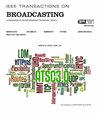Rate Control for Geometry-Based LiDAR Point Cloud Compression via Multi-Factor Modeling
IF 4.8
1区 计算机科学
Q2 ENGINEERING, ELECTRICAL & ELECTRONIC
引用次数: 0
Abstract
Geometry-based Point Cloud Compression (G-PCC) standard developed by the Moving Picture Experts Group has shown a promising prospect for compressing extremely sparse point clouds captured by the Light Detection And Ranging (LiDAR) equipment. However, as an essential functionality for low delay and limited bandwidth transmission, rate control for Geometry-based LiDAR Point Cloud Compression (G-LPCC) has not been fully studied. In this paper, we propose a rate control scheme for G-LPCC. We first adopt the best configuration of G-PCC for the LiDAR point cloud as the basis in terms of the Rate-Distortion (R-D) performance, which is the predictive tree (PT) for geometry compression and Region Adaptive Haar Transform (RAHT) for attribute compression. The common challenge of designing rate control algorithms for PT and RAHT is that their rates are determined by multiple factors. To address that, we propose a基于多因素建模的几何激光雷达点云压缩速率控制
由运动图像专家组开发的基于几何的点云压缩(G-PCC)标准显示了压缩由光探测和测距(LiDAR)设备捕获的极稀疏点云的良好前景。然而,作为低延迟和有限带宽传输的基本功能,基于几何的激光雷达点云压缩(G-LPCC)的速率控制尚未得到充分研究。本文提出了一种G-LPCC的速率控制方案。我们首先采用了LiDAR点云的G-PCC的最佳配置作为率失真(R-D)性能的基础,即用于几何压缩的预测树(PT)和用于属性压缩的区域自适应哈尔变换(RAHT)。设计PT和RAHT的速率控制算法的共同挑战是它们的速率由多种因素决定。为了解决这个问题,我们提出了一种用于PT的l域速率控制算法,该算法将最小弧长表达式中的各种几何影响因素统一起来,以确定最终速率。建立了以$\ mathm {d}l$为特征的幂型几何速率曲线。通过分析不同量化参数的失真行为,提出了一种自适应比特率控制方法来提高R-D性能。此外,我们从之前的2D视频速率控制中借用了$\rho $因子,并成功地应用到RAHT速率控制中。建立了以$\rho $为特征的简单清晰的线性属性率曲线模型,并提出了一种基于累积分布函数的相应参数估计方法用于比特率控制。实验结果表明,所提出的速率控制算法可以在增加Bjontegaard-Delta-rate (BD-rate)增益的情况下实现精确的速率控制。
本文章由计算机程序翻译,如有差异,请以英文原文为准。
求助全文
约1分钟内获得全文
求助全文
来源期刊

IEEE Transactions on Broadcasting
工程技术-电信学
CiteScore
9.40
自引率
31.10%
发文量
79
审稿时长
6-12 weeks
期刊介绍:
The Society’s Field of Interest is “Devices, equipment, techniques and systems related to broadcast technology, including the production, distribution, transmission, and propagation aspects.” In addition to this formal FOI statement, which is used to provide guidance to the Publications Committee in the selection of content, the AdCom has further resolved that “broadcast systems includes all aspects of transmission, propagation, and reception.”
 求助内容:
求助内容: 应助结果提醒方式:
应助结果提醒方式:


